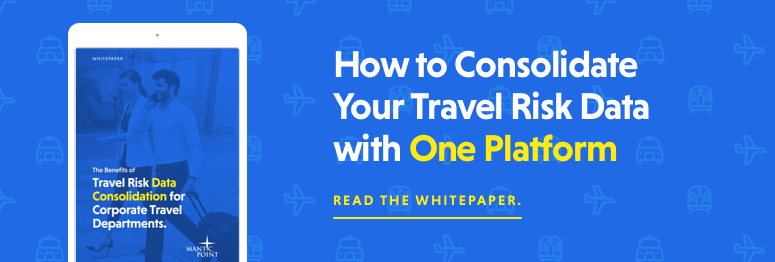The Top 7 Corporate Travel Trends for 2018
Posted by Mike Atherton on 02 January, 2018
Travel Risk Management Travel Apps News Traveller Tracking Travel Risk Assessment

2017 was a transformative year for corporate travel, and much of what we saw looks like a foretaste of what’s to come in the years ahead. From the rise of AI to increased traveller anxiety and acceleration of NDC standards, many of 2017’s travel trends look to continue and, in some cases, escalate in 2018. Here’s a closer look at what to expect in the coming year.
1. Permanxiety to Continue
With the situation on the Korean peninsula looking increasingly precarious, deteriorating diplomatic relations between the U.S and just about everyone, and terror attacks striking major cities around the globe, the year to come is unlikely to be the one in which traveller anxiety eases.
Add to the mix changing visa and immigration regulations, climate change, and privacy wars, and it’s easy to understand why many business travellers feel more anxious than at any time since 2001.
The good news is that while traveller anxiety looks set to continue, TMCs and corporate travel managers have more tools than ever before for managing risk and easing travellers’ fears.
What's more, these tools are improving at a rapid pace. For example, just a few years ago the provision of GPS trackers, employee check-in systems, weather updates, and emergency communication functionality through a single travel management app was unheard of. With technology such as biometrics, travel robots, and ever more sophisticated tracking on the horizon, business travel is becoming safer year-on-year. We can only hope that in time traveller perceptions follow suit.
2. Hotel Rate Availability Challenges to Continue
One of 2017’s most exasperating problems for travel managers has been hotel rate availability, and this looks set to continue in the year ahead. As hotels become more sophisticated in yield management techniques, business travellers are running into increasing difficulties finding and booking rooms at a preferred rate.
According to research by Advito, preferential rates were unavailable 24% of the time on a global basis, with the figure as high as 33% among European hotels during the last year. This trend can reduce the value of negotiated rates, so, to meet the challenge, travel managers should consider tracking rate availability and renegotiation with hotel partners where appropriate.
Why not make 2018 the year your TMC or travel department starts carrying out regular rate availability audits—you might be surprised at what it could save.
3. Accelerated Promotion of NDC Standards
2017 saw British Airways and sister carrier Iberia levy a surcharge on all fares originating from a non-NDC connection, following Lufthansa almost exactly two years before. And, with the announcement in November that Air France-KLM will follow suit from April 2018, it would be ill-advised to discount the possibility of other large carriers jumping on the NDC bandwagon.
For TMCs this represents both a challenge and an opportunity. For all its shortcomings (and there are many, it was even branded “not fit for purpose” back in the summer), the NDC standard has the potential to deliver some important benefits for TMCs. The NDC not only offers travel managers the ability to offer a greater range of products, it also presents an opportunity to address end-to-end airline distribution processes and deliver a more personalised travel experience.
So, it’s not all bad news, but, either way, all TMCs are going to have to bite the bullet sooner or later and the new year could be a great time to start taking steps towards preparation.
4. The Sharing Economy Isn’t Going Away
While 2017 represents an annus horribilis for Uber, as controversy reigned, and the ride-hailing service was denied a licence in 3 UK cities, the sharing economy made great strides.
A 2017 GBTA report revealed 30% of policies now allow business travellers to book accommodation on Airbnb. It also found that half of
The evidence is mounting that, despite many travel managers’ best efforts to drive their travellers away from the sharing economy, travellers,
5. Machine Learning to Deliver Savings
By now, most of us are used to the idea of machine learning
Machine Learning is helping travel managers save money through the automation of administrative tasks, resource savings, and its ability to deliver better-merchandising opportunities—bolstering supplier relationships. For travellers, the technology is being applied to everything from predictive pricing and the delivery of relevant, well-timed offers to forecasting the potential for flight delays and risk alerts, both delivering a traveller-centric experience and reducing trip friction.
6. The Impact of Brexit Continued
Brexit’s impact dominated most of 2016’s business trends posts, and, as negotiations enter the second phase and some sort of deal begins to take shape, Brexit will once again dominate the headlines in 2018. Of course, any Brexit-induced decline in the value of sterling is going to make overseas business travel more expensive for British travellers. However, regardless of cost, as that fateful date in March 2019 draws closer, it’s likely we’ll see increased business travel to Europe and further afield as companies search for new partners to prepare for life in a post-article 50 world.
And with sterling once again experiencing a slump after the latest round of negotiations, we’ll all be paying very close attention to the prices of budget carriers as the pound pushes up flight prices across the board.
This places the onus firmly on TMCs to get smarter. Whether through technology or by applying a few tricks of the trade, a good TMC will always find ways to keep costs down – even in a volatile market.
7. The Line Between Business and Leisure Blurs Further
“Bleisure” – the amalgamation of business and leisure travel, might be a relatively novel term, but in a few short years, it’s become a potentially lucrative segment for travel managers.
The number of business trips that include a leisure component continues to rise year-on-year, so for savvy travel managers with a finger to the wind of shifting lifestyle, generational, and corporate trends, 2018 could be the year to capitalise on the opportunity.
Obviously,
Many of the trends discussed are part of larger industry forces changing the way we think about business travel, so if you'd like to know more about what's in store for corporate travel then why not download our roundtable discussion with five industry thought-leaders?


